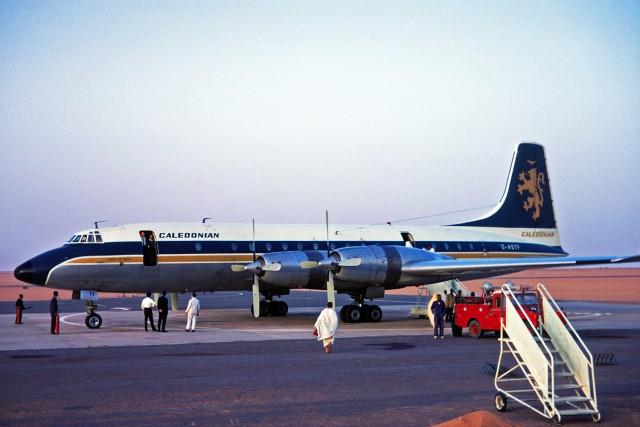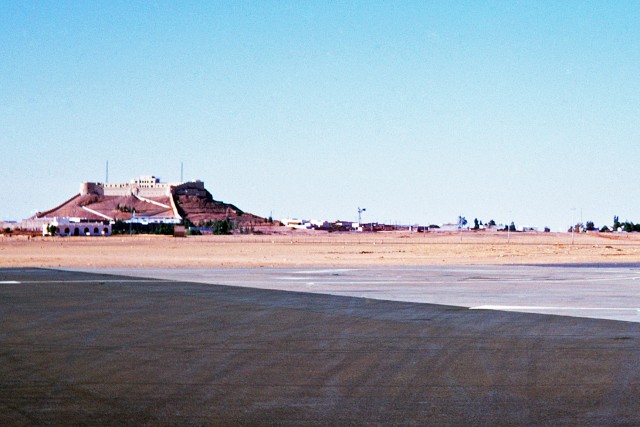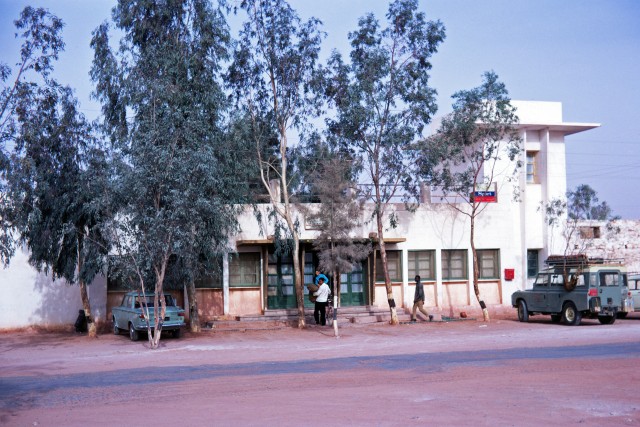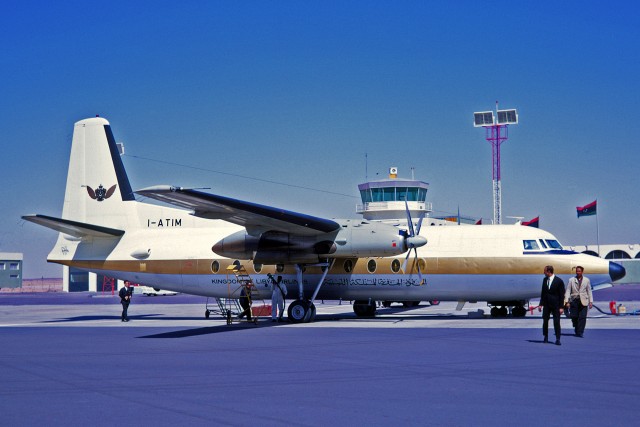
Caledonian Airways’ Bristol Britannia taken in February 1969 at Sabha Airport – Photo: Ken Fielding
Just after joining Caledonian Airways in February, 1969, I went to Tripoli, Libya, to help handle Caledonian’s Hajj contract, taking passengers to Saudi Arabia for the annual Hajj Pilgrimage, sub-contracted by KLA Kingdom of Libya Airlines. The contract was over eight weeks: three weeks ferrying Pilgrims outbound, a two-week hiatus while the Pilgrimage took place, and another three weeks for the return. The contract was for two Boeing 707-320C’s and a Bristol Britannia.

The French Colonial Fort seen next to Sebha in 1969 – Photo: Ken Fielding
Part of the contract with the Britannia was for a 10-day series of flights from Sebha, a small oasis town about 600 miles south of Tripoli in the Libyan Desert. The town’s most prominent feature was a ’˜Beau Geste’ style French Colonial Fort on the edge of the airfield, on the only hill for 200 miles. My hotel was the ’˜Sebha Palace’, not quite what you expect when the word ’˜palace’ is mentioned, but at least the rooms were en-suite. My bathroom had a 360 volt water heater (and a 220 volt supply). The wires were just pushed into the wall socket (no plug) and when it was switched on the lights dimmed and it took all day to heat enough water for a bath. The hotel restaurant only served chicken (well, we were 600 miles from nowhere). I had a bucket of fresh fish flown up from Tripoli on the ferry flight a few times and word soon got around. The restaurant was full on those evenings.

The Sebha Palace Hotel during my visit – Photo: Ken Fielding
Sebha, at that time, was remote although it had a brand new terminal just built by UK builders Wimpey, and I’d flown down from Tripoli on a KLA Fokker F.27 as Hajj Station Manager for the flight series. There were no catering facilities or fuel supplies at Sebha, and the fire service consisted of two men, a Land Rover, and a couple bits of hose!
The aircraft ferried in from Tripoli was already cleaned, catered (the famous Hajj Boxes) and fueled for the flight to Jeddah. This was almost the last flight in the series and went tech on arrival with a prop seal problem which put the number three prop into full feather. As there were no facilities to replace the prop seal, the aircraft had to do a three-engine ferry back to Tripoli, but with all that fuel on board and temperatures rising as the day progressed, it was rather overweight.
We off-loaded the Hajj Boxes to feed the passengers on the ground. However, the aircraft was still around 7,700lbs overweight for a three-engine ferry with a crew fast running out of duty time. We needed to offload around 600 gallons of fuel. What to do?
As there was no fuel tanker, the solution was interesting to say the least. While I got the KLA Station Manager to phone the local Esso supplier for twelve 50 gallon drums, the flight engineer fashioned a piece of aluminium sheet into a rough funnel. The local Esso man wanted us to pay for the drums but we told him he could keep the 600 gallons of kerosene instead — what a deal!

KLA Kingdom of Libya Airlines’ Fokker F27 Friendship taken in 1969 – Photo: Ken Fielding
45 minutes later he was there with the drums on the back of a truck, a very happy man. We loaded the drums, two at a time, onto a baggage cart and positioned it under the inboard engine nacelle. Using the engineer’s improvised funnel and a length of hose from the ‘fire service’, the flight engineer opened the tap. It took about 90 minutes to drain off the 600 gallons (and about a week for me to get rid of the smell of kerosene).
The aircraft departed soon after, still perhaps a bit on the heavy side! It wasn’t so much a takeoff as retracting the wheels at the end of the runway. Fortunately, being desert, the area around Sebha was reasonably flat and the aircraft disappeared into the distance climbing very slowly. The prop seal was replaced in Tripoli and the aircraft returned the following morning to resume the flight. The passengers? We didn’t have to worry about overnight hotel accommodations; they just went and camped in the desert next to the terminal.
Flying is not the way it used to be, right?
This post was written by Ken Fielding for AirlineReporter. Ken was born and raised in Liverpool in the UK and currently lives in Manchester, UK. He’s been an AvGeek since childhood and spent 43 years working in the airline business in Airport Services, Operations, Reservations, Sales, and Ticketing, retiring in 2005. He’s been taking color photos of aircraft since the early 1960’s and has an extensive collection of images on his Flickr page.